Lovely composition.
Tuesday, August 12, 2008
Charlotte (Made in Sheffield): Spotlight 7 Week 10
Archive of week 10 interview.
1) Tell us where you’re from and how that has influenced your photography.
I'm from Sheffield in South Yorkshire, England, but I've lived in London for about 10 years. I've never really given much thought as to whether where I'm from has influenced the shots I take. There is a lot of beautiful countryside on the doorstep of Sheffield which I spent a great deal of time in as a child, but I'm not really a fan of classic landscape photography. I tend to be drawn to more urban, gritty scenes - maybe in contrast to what I grew up with.
2) You just visited NYC on vacation (or Holiday as the British say). How is street photography different on the other side of the pond?
If anything the people I asked for their portrait in NYC were less suspicious of me and more willing to pose. New York does have quite a frenetic feel to it, so I think when it comes to 'classic' street photography, it is perhaps easier to 'hide', so to speak. Whilst there I saw a guy taking candid street shots, he was getting seriously close to people, but they didn't seem to notice, and he then just disappeared into the hustle and bustle of the sidewalk.
3) How do you approach random people on the street to take their photograph?
I find the quicker the exchange the better. Rather than launching into a big explanation, I just smile and politely ask if I can take their picture. Most people say yes, some people ask why. If they ask, I say it's just for my portfolio. Sometimes I might flatter them a little, such as telling them they have a great look, which tends to do the trick! I'm always a little nervous when I ask the first one of the day, sometimes my hands go a bit shaky which can be a bit problematic! Once you've asked the first though it gets much easier.
4) Tell us about your "Brief Encounters" series.
It's a series that has evolved rather than been planned. When I first got my digital camera (summer 2006) I found I began to take far more pictures than I ever did on film, mainly because cost was no longer an issue. I started a mini documentary project, in which I aimed to get 20 decent shots of London life each month for a year (they're buried in my Flickr stream somewhere). As part of these shots, I would get the odd street portrait. After a while I realised it was the street portraits that interested me most, and the documentary stuff took more of a back seat (although I do still like to mix it up). When I go out shooting now, I'm disappointed if I come back without any portraits.
5) I love how some of your street portraits are diptychs. What inspired you to show two different views like that?
I only recently discovered the wonders of diptychs when looking at all the amazing stuff on Flickr. I just began playing around one day, at first with two portrait shots of the same person, just with different expressions, then I realised that not only was it nice to see a face in close-up, but it was interesting to see a bit of context regarding their surroundings. I haven't seen a lot of diptychs like that, but I'm sure I'm by no means the first person to do it.
6) Tell us something we don’t know about one of the portraits chosen for Spotlight Seven.
I didn't know that Brian Haw apparently makes a point of not looking at the lens, so I count myself very lucky.
www.flickr.com/photos/madeinsheffield/2278026172/in/pool-...
7) If someone was going to buy you one piece of equipment at B&H, whatever you wanted, what would it have been?
Oh a D300, without a shadow of a doubt!
8) Are there any photographers that you admire or seek to emulate?
I love the work of Jane Bown, the resident portrait photographer for The Observer magazine & newspaper. I believe she's in her 80's now but still going strong. She takes beautiful, simple black & white portrait shots that cut right to the heart of her sitters. She still works on film, and uses natural light wherever possible. What I love the most is that she carries a light bulb with her, just in case she can't find suitable window light. Her job would be my dream job. Other leading photographers that I admire include Martin Parr, Mario Testino and Anton Corbijn. Flickr continues to be my main inspiration though, I'm astounded at some of the talent that's out there.
9) What are your goals as far as photography is concerned?
I don't have any major goals, I just hope I never lose the passion I have for it. Being recognised in any way is great, and like Eamon, I would love to be shortlisted for the NPG portrait prize. The most important thing for me is to keep taking pictures.
10) Show us a photograph you wish you took on Flickr.
This was tough, because there's so much great stuff to choose from. I think it has to be this one though: www.flickr.com/photos/mikepeters/2075215566/
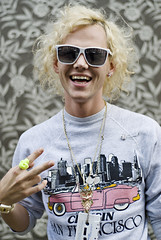
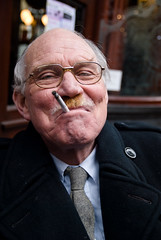
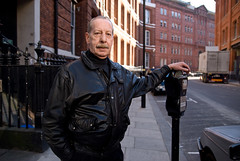
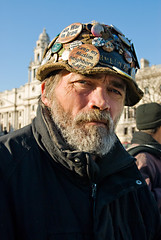
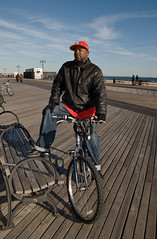
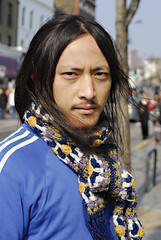



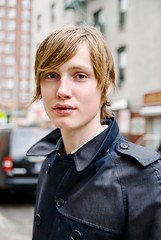
1) Tell us where you’re from and how that has influenced your photography.
I'm from Sheffield in South Yorkshire, England, but I've lived in London for about 10 years. I've never really given much thought as to whether where I'm from has influenced the shots I take. There is a lot of beautiful countryside on the doorstep of Sheffield which I spent a great deal of time in as a child, but I'm not really a fan of classic landscape photography. I tend to be drawn to more urban, gritty scenes - maybe in contrast to what I grew up with.
2) You just visited NYC on vacation (or Holiday as the British say). How is street photography different on the other side of the pond?
If anything the people I asked for their portrait in NYC were less suspicious of me and more willing to pose. New York does have quite a frenetic feel to it, so I think when it comes to 'classic' street photography, it is perhaps easier to 'hide', so to speak. Whilst there I saw a guy taking candid street shots, he was getting seriously close to people, but they didn't seem to notice, and he then just disappeared into the hustle and bustle of the sidewalk.
3) How do you approach random people on the street to take their photograph?
I find the quicker the exchange the better. Rather than launching into a big explanation, I just smile and politely ask if I can take their picture. Most people say yes, some people ask why. If they ask, I say it's just for my portfolio. Sometimes I might flatter them a little, such as telling them they have a great look, which tends to do the trick! I'm always a little nervous when I ask the first one of the day, sometimes my hands go a bit shaky which can be a bit problematic! Once you've asked the first though it gets much easier.
4) Tell us about your "Brief Encounters" series.
It's a series that has evolved rather than been planned. When I first got my digital camera (summer 2006) I found I began to take far more pictures than I ever did on film, mainly because cost was no longer an issue. I started a mini documentary project, in which I aimed to get 20 decent shots of London life each month for a year (they're buried in my Flickr stream somewhere). As part of these shots, I would get the odd street portrait. After a while I realised it was the street portraits that interested me most, and the documentary stuff took more of a back seat (although I do still like to mix it up). When I go out shooting now, I'm disappointed if I come back without any portraits.
5) I love how some of your street portraits are diptychs. What inspired you to show two different views like that?
I only recently discovered the wonders of diptychs when looking at all the amazing stuff on Flickr. I just began playing around one day, at first with two portrait shots of the same person, just with different expressions, then I realised that not only was it nice to see a face in close-up, but it was interesting to see a bit of context regarding their surroundings. I haven't seen a lot of diptychs like that, but I'm sure I'm by no means the first person to do it.
6) Tell us something we don’t know about one of the portraits chosen for Spotlight Seven.
I didn't know that Brian Haw apparently makes a point of not looking at the lens, so I count myself very lucky.
www.flickr.com/photos/madeinsheffield/2278026172/in/pool-...
7) If someone was going to buy you one piece of equipment at B&H, whatever you wanted, what would it have been?
Oh a D300, without a shadow of a doubt!
8) Are there any photographers that you admire or seek to emulate?
I love the work of Jane Bown, the resident portrait photographer for The Observer magazine & newspaper. I believe she's in her 80's now but still going strong. She takes beautiful, simple black & white portrait shots that cut right to the heart of her sitters. She still works on film, and uses natural light wherever possible. What I love the most is that she carries a light bulb with her, just in case she can't find suitable window light. Her job would be my dream job. Other leading photographers that I admire include Martin Parr, Mario Testino and Anton Corbijn. Flickr continues to be my main inspiration though, I'm astounded at some of the talent that's out there.
9) What are your goals as far as photography is concerned?
I don't have any major goals, I just hope I never lose the passion I have for it. Being recognised in any way is great, and like Eamon, I would love to be shortlisted for the NPG portrait prize. The most important thing for me is to keep taking pictures.
10) Show us a photograph you wish you took on Flickr.
This was tough, because there's so much great stuff to choose from. I think it has to be this one though: www.flickr.com/photos/mikepeters/2075215566/










Mike Peters: Spotlight 7 Week 9
Week 10 featured Mike Peters.
1) Where did you grow up and where are you now? How have these places influenced your photography?
I grew up in Kearny, NJ, a highly industrialized town that lies between the Hackensack River and Jersey City on the east and the Passaic River and Newark on the west. Kearny is a blue collar town, home to people who work hard for a living. When I was a kid recent immigrants from Scotland, Ireland, Italy and Poland were my neighbors, and now it is populated with people from Portugal and South America. Kearny was and still is a stop along the way for the American Dream as new arrivals work their way up and out to the more pleasant but bland suburbs, which is were I live now about 10 miles west in Verona.
Kearny very much informed my eye. It is a gritty place, close and crowded, a mash up of iron bridges, super highways, 19th century factories, multi-family homes, delicatessens and bars. Everyone fights for parking on the street. I always knew when to go home for dinner when I was a kid because all of the factory whistles would sound off at 5 pm and could clearly be heard over the constant roar of industry that filled the air until the early morning hours. Silence only occurred on Sundays.
In my photography I am drawn to what I know. The urban landscape is where I am most comfortable, concrete and asphalt are my preferred material to have under foot. People that you would normally pass by, the ones that blend into their environment, are the people that I usually am drawn to photograph. Growing up in Kearny taught me that in order to survive one needed persist and endure, Those who aspired for something more were considered high-hats. My photography is tightly intertwined with where I grew up and who I am, as a product of my environment. I feel no desire to distance myself from my past.
2) What is it you love about Coney Island?
Where do I begin? Coney Island is a truly authentic place, untouched by the shine of large corporate greed. Times Square was once a place like that too, only more scary and foul smelling, but now it's worse. I hope the same fate does not await Coney. I really like and relate to the people who come to Coney, the locals and long-timers that keep the place real. These are the same working class people that I grew up with, those who persist and blend into the scenery because they are the scenery. Coney Island and the people that live and work there, embody the spirit of endurance and persistence, they have a patina of grit and hard use that is worn with honor and dignity.
3) Can you show us an early photograph you took which made you really excited about photography?
www.mikepeters.com/photographs/Portraits_1978_now/slides/...
This photo is one of the first that really got the ball rolling for me. The subject, my mother, is surrounded by her natural environment and everything says something about who she is and what she's all about. For me it was the first time I was able to deliberately capture a descriptive narrative of the person in the photo that dug beneath the surface, even just a little bit. This photo, along with much of my early work was shot using a 4x5 camera.
4) How do you approach random people on the street to take their photograph?
I tend to be pretty obvious about what I'm up to, carrying a 120 slr is hard to hide. I usually just walk up, raise the camera, compose, focus and make the exposure. Sometimes they see me coming, sometimes not, either way I look them in the eye and smile when I'm done. There are times when I'm in the middle of a conversation when I'll just raise the camera and make a photo while I'm talking. And there have been one or two instances where someone has stopped me and asked if I would take a photo of them. There is no one way to do it. The main thing is not to be sneaky or tentative. Be bold and confident and people will usually accept your presence.
5) Have you ever encountered an angry subject
www.flickr.com/photos/mikepeters/330545730/in/set-7215759...
I saw this guy selling books on the street as I was walking towards him. He ducked into his van, with his back to me he rummaged around for about 2 - 3 minutes, I set up on the opposite side of his table waiting for him to turn back towards me. When he did, I made the exposure, but in that same instant he saw me and ducked back inside. Yelled "you mother-fucker don't take my picture, I'll kick your ass." I smiled, said thank you and walked away.
6) Tell us something about your favorite portrait of the one's chosen for Spotlight Seven.
www.flickr.com/photos/mikepeters/1745018651/in/set-721576...
This image pretty much sums up the feeling that was prevalent that evening, the final day of Astroland in 2007, and perhaps forever. It was a celebration for the end of summer and perhaps for Coney Island as we know it. There was a real sadness and resignation on the face of the woman. All bright and glittery with music and dancing, yet sad and wistful.
7) If you could photograph one person, living or dead who would it be?
I really cannot think of any one person, I'm pretty much drawn to just regular people.
8) What are your expectations/aspirations regarding photography in the next few years?
I really just want to keep finding projects that interest me, and getting the resulting images out there and seen.
9) What piece of equipment is on your wish list?
At this point I have way too much equipment and only wish for more time to shoot and produce my personal work.
10) Show us a photograph you wish you took on flickr.
www.flickr.com/photos/urbanphotos/2076096653/in/set-72157...










1) Where did you grow up and where are you now? How have these places influenced your photography?
I grew up in Kearny, NJ, a highly industrialized town that lies between the Hackensack River and Jersey City on the east and the Passaic River and Newark on the west. Kearny is a blue collar town, home to people who work hard for a living. When I was a kid recent immigrants from Scotland, Ireland, Italy and Poland were my neighbors, and now it is populated with people from Portugal and South America. Kearny was and still is a stop along the way for the American Dream as new arrivals work their way up and out to the more pleasant but bland suburbs, which is were I live now about 10 miles west in Verona.
Kearny very much informed my eye. It is a gritty place, close and crowded, a mash up of iron bridges, super highways, 19th century factories, multi-family homes, delicatessens and bars. Everyone fights for parking on the street. I always knew when to go home for dinner when I was a kid because all of the factory whistles would sound off at 5 pm and could clearly be heard over the constant roar of industry that filled the air until the early morning hours. Silence only occurred on Sundays.
In my photography I am drawn to what I know. The urban landscape is where I am most comfortable, concrete and asphalt are my preferred material to have under foot. People that you would normally pass by, the ones that blend into their environment, are the people that I usually am drawn to photograph. Growing up in Kearny taught me that in order to survive one needed persist and endure, Those who aspired for something more were considered high-hats. My photography is tightly intertwined with where I grew up and who I am, as a product of my environment. I feel no desire to distance myself from my past.
2) What is it you love about Coney Island?
Where do I begin? Coney Island is a truly authentic place, untouched by the shine of large corporate greed. Times Square was once a place like that too, only more scary and foul smelling, but now it's worse. I hope the same fate does not await Coney. I really like and relate to the people who come to Coney, the locals and long-timers that keep the place real. These are the same working class people that I grew up with, those who persist and blend into the scenery because they are the scenery. Coney Island and the people that live and work there, embody the spirit of endurance and persistence, they have a patina of grit and hard use that is worn with honor and dignity.
3) Can you show us an early photograph you took which made you really excited about photography?
www.mikepeters.com/photographs/Portraits_1978_now/slides/...
This photo is one of the first that really got the ball rolling for me. The subject, my mother, is surrounded by her natural environment and everything says something about who she is and what she's all about. For me it was the first time I was able to deliberately capture a descriptive narrative of the person in the photo that dug beneath the surface, even just a little bit. This photo, along with much of my early work was shot using a 4x5 camera.
4) How do you approach random people on the street to take their photograph?
I tend to be pretty obvious about what I'm up to, carrying a 120 slr is hard to hide. I usually just walk up, raise the camera, compose, focus and make the exposure. Sometimes they see me coming, sometimes not, either way I look them in the eye and smile when I'm done. There are times when I'm in the middle of a conversation when I'll just raise the camera and make a photo while I'm talking. And there have been one or two instances where someone has stopped me and asked if I would take a photo of them. There is no one way to do it. The main thing is not to be sneaky or tentative. Be bold and confident and people will usually accept your presence.
5) Have you ever encountered an angry subject
www.flickr.com/photos/mikepeters/330545730/in/set-7215759...
I saw this guy selling books on the street as I was walking towards him. He ducked into his van, with his back to me he rummaged around for about 2 - 3 minutes, I set up on the opposite side of his table waiting for him to turn back towards me. When he did, I made the exposure, but in that same instant he saw me and ducked back inside. Yelled "you mother-fucker don't take my picture, I'll kick your ass." I smiled, said thank you and walked away.
6) Tell us something about your favorite portrait of the one's chosen for Spotlight Seven.
www.flickr.com/photos/mikepeters/1745018651/in/set-721576...
This image pretty much sums up the feeling that was prevalent that evening, the final day of Astroland in 2007, and perhaps forever. It was a celebration for the end of summer and perhaps for Coney Island as we know it. There was a real sadness and resignation on the face of the woman. All bright and glittery with music and dancing, yet sad and wistful.
7) If you could photograph one person, living or dead who would it be?
I really cannot think of any one person, I'm pretty much drawn to just regular people.
8) What are your expectations/aspirations regarding photography in the next few years?
I really just want to keep finding projects that interest me, and getting the resulting images out there and seen.
9) What piece of equipment is on your wish list?
At this point I have way too much equipment and only wish for more time to shoot and produce my personal work.
10) Show us a photograph you wish you took on flickr.
www.flickr.com/photos/urbanphotos/2076096653/in/set-72157...










Ryan Schude: Spotlight 7 Week 8
Week 8 featured the talented Ryan Schude.
1) Tell us briefly about where you're from and where you're living now and how either have influenced your photography?
I grew up in a suburb of Chicago until I was 18 and then moved to California where I am still living. Both places have influenced the Americana aspects of the subject matter I choose to shoot.
2) Talk about the series of portraits where people are standing holding something in their hands, as seen here: www.flickr.com/photos/ryanschude/388948413
This series was inspired by the wonderfully colored locations around Los Angeles. I wanted to find an interesting way to use the locations that wouldn't be your standard girl/fashion photo. The series is far from finished but I have been pulled into the larger production tableau style photos which are taking up the majority of my time and have put the other series on hold for now.
3) Whose work has influenced you over the years (you can include someone on Flickr if you have one)?
Gregory Crewdson, Philip Lorca Dicorcia, Jeff Wall, and David la Chapelle were a few that really got me excited about photography in the beginning. I also had a strong affinity towards street photographers like Henry Cartier Bresson, Stephen Shore and Gary Winograd. More recently i've found people like julia fullerton-batten and eric ogden producing contemporary work I've enjoyed quite a bit.
4) Lighting is obviously essential for some of your work, what are you trying to achieve through using artificial light?
That's a good question because I used to shoot a lot of natural light street photos and loved the chance scenarios documentary work allowed but when i started incorporating artificial light I found the control more suitable towards a staged setting. I suppose the added light simply makes it more obviously fabricated which in the end adds to the drama of the whole process.
5) What would you recommend to someone who is just starting out but wants to light their shots like you do...such as a basic startup kit?
Hmmm, that's a question a lot of photographers ask me and it always seems best to determine how much you want to spend and go from there. You don't really need an expensive lighting set to get the effect, it just makes it easier. The old Lumedyne kits are great because they are relatively cheap and portable while still allowing for essential lighting modifiers like grid spots and softboxes. If you have the money available I would always recommend getting the best equipment you can afford because it is generally worth it and you will just end up buying it eventually anyways after you realize the shortcomings of the cheap stuff.
6) What's something in photography that you've never done but want to try?
I would like to stage a scene in a busy downtown area where we block off the streets and have hundreds of extras all under careful direction.
7) Which is your favorite photo we chose for Spotlight Seven, tell us something about it?
I think the pumpkin one would be my favorite of those 10. It's more because of the personal process that went into creating it since I walked by that apartment complex and realized I had to make a photo there but didn't know what to do with it. I had scouted out a dozen or so similar locations for the food series and got really excited when i saw the potential for matching the pumpkin with that environment. I then found the perfect dress and fortunately the model and hair/makeup all came together just right. her expression worked just as I imagined it, she really took direction well.
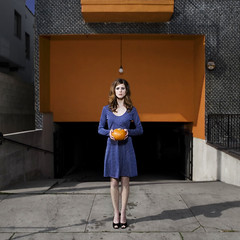
8) What are your professional aspirations in the next few years?
Ideally, I will continue to push the type of work that interests me artistically as opposed to catering the work to a more "commercially viable" perspective.
9) These two photos are just amazing: www.flickr.com/photos/ryanschude/2220901137/ www.flickr.com/photos/ryanschude/1702100719/
Since they aren't portraits of single people though I can't invite them into Spotlight Seven, but I'd love to hear a little bit about them.
These photos represent the style of photography I am most interested in and the direction i hope to continue to head in the immediate future. there is a strong attention to detail that goes into each one regarding props, talent, wardrobe, location, lighting, and finally creating a moment that ties the whole scene together.
10) Show us a photo on Flickr that you wish you had taken.
www.flickr.com/photos/dirtysmalls/389617784/
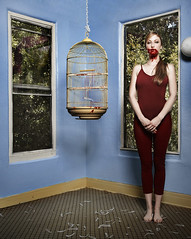
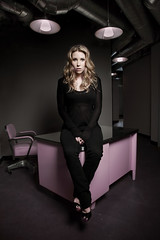
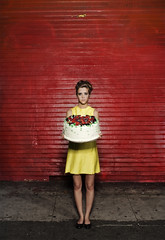

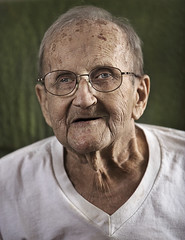
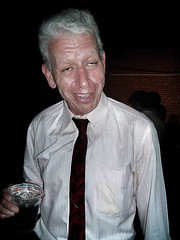
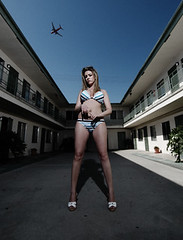
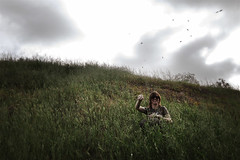
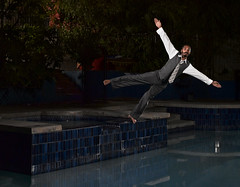
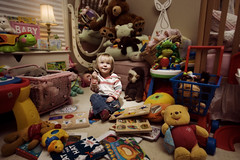
1) Tell us briefly about where you're from and where you're living now and how either have influenced your photography?
I grew up in a suburb of Chicago until I was 18 and then moved to California where I am still living. Both places have influenced the Americana aspects of the subject matter I choose to shoot.
2) Talk about the series of portraits where people are standing holding something in their hands, as seen here: www.flickr.com/photos/ryanschude/388948413
This series was inspired by the wonderfully colored locations around Los Angeles. I wanted to find an interesting way to use the locations that wouldn't be your standard girl/fashion photo. The series is far from finished but I have been pulled into the larger production tableau style photos which are taking up the majority of my time and have put the other series on hold for now.
3) Whose work has influenced you over the years (you can include someone on Flickr if you have one)?
Gregory Crewdson, Philip Lorca Dicorcia, Jeff Wall, and David la Chapelle were a few that really got me excited about photography in the beginning. I also had a strong affinity towards street photographers like Henry Cartier Bresson, Stephen Shore and Gary Winograd. More recently i've found people like julia fullerton-batten and eric ogden producing contemporary work I've enjoyed quite a bit.
4) Lighting is obviously essential for some of your work, what are you trying to achieve through using artificial light?
That's a good question because I used to shoot a lot of natural light street photos and loved the chance scenarios documentary work allowed but when i started incorporating artificial light I found the control more suitable towards a staged setting. I suppose the added light simply makes it more obviously fabricated which in the end adds to the drama of the whole process.
5) What would you recommend to someone who is just starting out but wants to light their shots like you do...such as a basic startup kit?
Hmmm, that's a question a lot of photographers ask me and it always seems best to determine how much you want to spend and go from there. You don't really need an expensive lighting set to get the effect, it just makes it easier. The old Lumedyne kits are great because they are relatively cheap and portable while still allowing for essential lighting modifiers like grid spots and softboxes. If you have the money available I would always recommend getting the best equipment you can afford because it is generally worth it and you will just end up buying it eventually anyways after you realize the shortcomings of the cheap stuff.
6) What's something in photography that you've never done but want to try?
I would like to stage a scene in a busy downtown area where we block off the streets and have hundreds of extras all under careful direction.
7) Which is your favorite photo we chose for Spotlight Seven, tell us something about it?
I think the pumpkin one would be my favorite of those 10. It's more because of the personal process that went into creating it since I walked by that apartment complex and realized I had to make a photo there but didn't know what to do with it. I had scouted out a dozen or so similar locations for the food series and got really excited when i saw the potential for matching the pumpkin with that environment. I then found the perfect dress and fortunately the model and hair/makeup all came together just right. her expression worked just as I imagined it, she really took direction well.

8) What are your professional aspirations in the next few years?
Ideally, I will continue to push the type of work that interests me artistically as opposed to catering the work to a more "commercially viable" perspective.
9) These two photos are just amazing: www.flickr.com/photos/ryanschude/2220901137/ www.flickr.com/photos/ryanschude/1702100719/
Since they aren't portraits of single people though I can't invite them into Spotlight Seven, but I'd love to hear a little bit about them.
These photos represent the style of photography I am most interested in and the direction i hope to continue to head in the immediate future. there is a strong attention to detail that goes into each one regarding props, talent, wardrobe, location, lighting, and finally creating a moment that ties the whole scene together.
10) Show us a photo on Flickr that you wish you had taken.
www.flickr.com/photos/dirtysmalls/389617784/










Martin Prihoda: Spotlight 7 Week 7
Week 7 photographer Martin Prihoda is no longer active on Flickr, but you can find some of his work here.
This week Spotlight Seven features Martin Prihoda as presented by guest curator Ryan Brenizer.
1) Where are you from and where do you live now?
I'm originally from Vancouver and though I've spent much time abroad, I still call this beautiful city home.
2) You also list yourself as a filmmaker and writer. What sort of projects do you do with these, and how do they intersect with your photography?
Filmmaking and photography are similar in so many ways yet worlds apart. A photograph has the potential to be iconic in a way a film can't be, yet a film can elaborate and contextualize in a way that isn't possible for a photograph. A picture is a frozen moment in time, leaving the observer to determine a past and a future. A film, however, can set the past and determine the future, it can flash back or fast forward, it is a million frozen moments strung together to create a perceived linear timeline.
I guess to say I prefer one over the other would be like saying I prefer a spoon over a fork...I'd have to know what I was eating. I enjoy working in film for the reason that I can spend time developing a script with actors over a linear timeline. Everyone I know loves movies, its the populist tradition of our time so its a great way to communicate as an artist.
I'm currently writing a feature film which I will be directing, its in the embryonic stages and I'm really excited about the process. To make a film is a two to three year process, in the mean and between time I go out an shoot stills...it keeps me sane.
3) You do a lot of location lighting. What are your go-to lights, and how many people are usually working on your shoots? I love shooting outdoors with strobes, it gives such an inspired, unusual and dramatic feel to a photo. If its just me and a few buddies I'll bring out my 2 600w/s Visatek strobes, pocket wizards and a few light stands, as well as a soft-box or two. If its a bigger job I'll work with and assistant or two, location manager, producer and a hair and makeup girl. I'll usually have a Profoto package on hand for these shoots, battery packs and generators. I'll shoot anything from a Canon 30d to Nikon D3 to good ol fashioned medium format on a Hasselblad.
4) A lot of these images are from your fantastic yoga series. What about yoga speaks to you (other than the fact that it looks really cool)?
I practice Yoga daily. I credit this, as well as a meditation practice, to deepening my creative abilities and tapping into my authentic self. 'Yoga' is a Sanskrit word meaning 'union.' This union refers to the union of our true self with that of the universal consciousness and its from this unity that all creation arises. The more we can experience silence and connection with ourselves, the more abundance we can bring into our lives.
and its a great workout ;-)
5) Are there any photographers that you admire or seek to emulate?
Of course, absolutely. As I began to learn how to light with more efficiency I began to look for ways to enhance the look and feel of my work though post production. I saw Joey Lawrence's work and I realized that we had very similar lighting styles, but his post work was where I wanted to be. I began a correspondence with him and he shared with me his use of layers as well as dodging and burning techniques. It definitely brought my work up to the next level. He's a great artist though and was very willing to share. Though there's similarities in our styles, I write and develop my own original concepts.
I also admire Michael Grecco's work and to be honest there's a lot more; James Nachtway for example. 6) What made you decide to focus on portraiture instead of another area of photography?
I love people. We are all reflections of each other in some way. All of life is relational and when you see someone on the street, whether you like them or not, its like seeing a big mirror. I suppose I see alot of myself in my subjects. In a face, after all, is the map of life...
7) Talk about one of the photos we chose for Spotlight Seven.

I particularly love this photo. David is a good friend of mine and we wanted to do a father/son portrait but we wanted something different. I asked him how much his son weighed and he said about thirty pounds, for some reason I immediately thought of dumb-bells and the shot was born. Its shot simply with a strobe and softbox above camera. A wide angle lens and a gloomy sky helped out.
8) It seems you do a lot of work that you don't show on Flickr -- the coprorate and editorial stuff. What is this part of your life like, and what makes you decide an image is "Flickr-appropriate"?
If I'm proud of it I'll put it up. I don't worry to much much if its corporate or not. I do tend to be fairly strict with my selections though.
9) Tell us one of the funniest moments you've had on a shoot.
We were doing a mock suicide scene once. A guy was supposed to be standing on a bridge looking down. We were shooting from below and giving orders to the actor from a walkie talkie he had in his jacket.
He was only supposed to be looking down, contemplating, but a passing driver had called the cops saying there was a 'jumper,' next thing we knew our actor was getting tackled down by a couple of officers...scared the s**t out of him. and us.
10) Show us a photo on Flickr that you wish you had taken.
I've liked this shot for awhile. I like Zuan's work, it has energy and movement coupled with a great technical skill. This photo is a particular favorite.
www.flickr.com/photos/zuan/441349287/
This week Spotlight Seven features Martin Prihoda as presented by guest curator Ryan Brenizer.
1) Where are you from and where do you live now?
I'm originally from Vancouver and though I've spent much time abroad, I still call this beautiful city home.
2) You also list yourself as a filmmaker and writer. What sort of projects do you do with these, and how do they intersect with your photography?
Filmmaking and photography are similar in so many ways yet worlds apart. A photograph has the potential to be iconic in a way a film can't be, yet a film can elaborate and contextualize in a way that isn't possible for a photograph. A picture is a frozen moment in time, leaving the observer to determine a past and a future. A film, however, can set the past and determine the future, it can flash back or fast forward, it is a million frozen moments strung together to create a perceived linear timeline.
I guess to say I prefer one over the other would be like saying I prefer a spoon over a fork...I'd have to know what I was eating. I enjoy working in film for the reason that I can spend time developing a script with actors over a linear timeline. Everyone I know loves movies, its the populist tradition of our time so its a great way to communicate as an artist.
I'm currently writing a feature film which I will be directing, its in the embryonic stages and I'm really excited about the process. To make a film is a two to three year process, in the mean and between time I go out an shoot stills...it keeps me sane.
3) You do a lot of location lighting. What are your go-to lights, and how many people are usually working on your shoots? I love shooting outdoors with strobes, it gives such an inspired, unusual and dramatic feel to a photo. If its just me and a few buddies I'll bring out my 2 600w/s Visatek strobes, pocket wizards and a few light stands, as well as a soft-box or two. If its a bigger job I'll work with and assistant or two, location manager, producer and a hair and makeup girl. I'll usually have a Profoto package on hand for these shoots, battery packs and generators. I'll shoot anything from a Canon 30d to Nikon D3 to good ol fashioned medium format on a Hasselblad.
4) A lot of these images are from your fantastic yoga series. What about yoga speaks to you (other than the fact that it looks really cool)?
I practice Yoga daily. I credit this, as well as a meditation practice, to deepening my creative abilities and tapping into my authentic self. 'Yoga' is a Sanskrit word meaning 'union.' This union refers to the union of our true self with that of the universal consciousness and its from this unity that all creation arises. The more we can experience silence and connection with ourselves, the more abundance we can bring into our lives.
and its a great workout ;-)
5) Are there any photographers that you admire or seek to emulate?
Of course, absolutely. As I began to learn how to light with more efficiency I began to look for ways to enhance the look and feel of my work though post production. I saw Joey Lawrence's work and I realized that we had very similar lighting styles, but his post work was where I wanted to be. I began a correspondence with him and he shared with me his use of layers as well as dodging and burning techniques. It definitely brought my work up to the next level. He's a great artist though and was very willing to share. Though there's similarities in our styles, I write and develop my own original concepts.
I also admire Michael Grecco's work and to be honest there's a lot more; James Nachtway for example. 6) What made you decide to focus on portraiture instead of another area of photography?
I love people. We are all reflections of each other in some way. All of life is relational and when you see someone on the street, whether you like them or not, its like seeing a big mirror. I suppose I see alot of myself in my subjects. In a face, after all, is the map of life...
7) Talk about one of the photos we chose for Spotlight Seven.

I particularly love this photo. David is a good friend of mine and we wanted to do a father/son portrait but we wanted something different. I asked him how much his son weighed and he said about thirty pounds, for some reason I immediately thought of dumb-bells and the shot was born. Its shot simply with a strobe and softbox above camera. A wide angle lens and a gloomy sky helped out.
8) It seems you do a lot of work that you don't show on Flickr -- the coprorate and editorial stuff. What is this part of your life like, and what makes you decide an image is "Flickr-appropriate"?
If I'm proud of it I'll put it up. I don't worry to much much if its corporate or not. I do tend to be fairly strict with my selections though.
9) Tell us one of the funniest moments you've had on a shoot.
We were doing a mock suicide scene once. A guy was supposed to be standing on a bridge looking down. We were shooting from below and giving orders to the actor from a walkie talkie he had in his jacket.
He was only supposed to be looking down, contemplating, but a passing driver had called the cops saying there was a 'jumper,' next thing we knew our actor was getting tackled down by a couple of officers...scared the s**t out of him. and us.
10) Show us a photo on Flickr that you wish you had taken.
I've liked this shot for awhile. I like Zuan's work, it has energy and movement coupled with a great technical skill. This photo is a particular favorite.
www.flickr.com/photos/zuan/441349287/
Jill Coleman: Spotlight 7 Week 6
Please welcome Jill Coleman, our week 6 featured photographer.
1) Why black and white?
I actually like both color and Black and White. It depends on my mood, right now its B&W. I grew up looking at pictures in Life magazine etc and love the Magnum type style but then again I love National Geographic images too. Dorothea Lange has to be my greatest influence and I love the work of the South African photographer , Obie Oberholzer.
2) Where do you live and what effect does it have on your
photography?
I live in South Africa, in the Western Cape in an area called The Klein Karoo. I move around quite often and wherever I am I adapt for my photography. There is also great light here. The people I photograph are my neighbors and I am mostly in walking distance of my subjects.
3) Tell us about this set you have of people from Klein Karoo.
Probably the best way to describe the series, is by reading this article published in Issue 13 of JPG Magazine.
4) I noticed that you have many images with 2 or 3 people, how is the dynamic different for you as compared to shooting a single subject portrait?
When I stared I only used to only shoot one person but then I wanted to include families, siblings etc but I always notice one special expression in my group shots and the viewer normally is drawn to that person. I always talk while I am shooting and it distracts the person and then they feel more at ease.
5) Any influences on flickr or streams you love to watch?
I would have to say Rui Palha, Junku – Newcleus and lately Carf.
6) Are there any subjects you won't photograph?
Yes, violent images and there is a lot of alcoholism here and I will not show people losing their dignity. Cruelty to animals or children, cruelty to anyone. I will try and stop it but I won’t photograph it.
7) How personally involved do you get with your subjects?
I get quite personally involved but at the same time I respect people’s cultures and way of life and I will not interfere in that. Some become friends, some prefer to keep me at a distance and I respect that. I always try to give folks I shoot the photographs, and most families here have them in their homes.
8) What camera is on your wish list?
I would like to upgrade eventually but I am happy with the 350D, I certainly need some more lenses as I only have two and one is broken. I supposed I would love to try the Leica digital one day but I make do with what I have.
9) Out of the 10 photos chosen for Spotlight Seven, which one is your favorite? tell us something about it.
I like the untitled one of Trish, the close up of the woman, her hand and rings and bangles the one false nail missing, I took it in Australia when I spent some time there last year and to me, it captures her perfectly, a fascinating and real woman. Of all my photographs I like Sophia the best. The two little boys boys playing the home made guitar.
10) What are your goals in regards to your photography in the near future?
I don’t really set goals, I take my life day by day, as long as I enjoy what I do with my photography I am content. I am not at all competitive in photography and while I will enter a few competitions a year, I do not get involved much in the “you click mine, I will click yours” as it really does not make much sense to me but I try to answer every single person who writes to me and I do have a really bad internet line so I can’t look at others work as much as I would like to. I will be traveling to the U.S.A in March this year so I would love to meet other photographers and learn from them and of course just to shoot in a different setting is incredibly exciting. I certainly want to exhibit and feel as if I am almost ready to, I think in photography , you need to “pay your dues”…and not just expect everything to fall into your lap. I do not make a living from photography, I work for my family business, I am a very simple person and while photography is my passion I also am very grounded and realize that other things in life are just as important like family, friends etc. I think photography is a wonderful creative outlet and it is great that so many people have access to it now via the internet, digital etc and anything that promotes creativity is good. Yes there is a lot of crap too but at least people try and it should be available to everyone, not be an “exclusive club”. ! Some will be better than others and have more success but that is the same with everything in life, I am grateful for what I have achieved and most of all I suppose I strive for reality in my work and am thankful to everyone it may inspire.
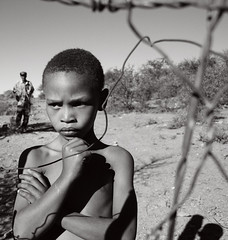


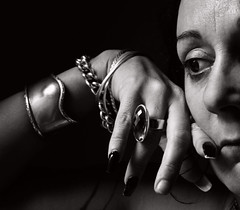

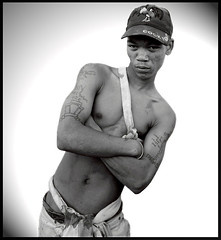
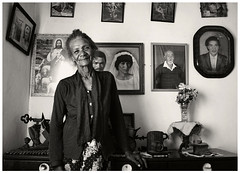
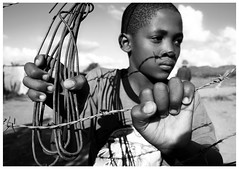
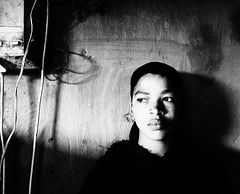
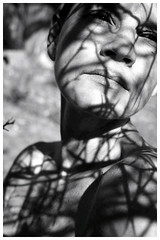
1) Why black and white?
I actually like both color and Black and White. It depends on my mood, right now its B&W. I grew up looking at pictures in Life magazine etc and love the Magnum type style but then again I love National Geographic images too. Dorothea Lange has to be my greatest influence and I love the work of the South African photographer , Obie Oberholzer.
2) Where do you live and what effect does it have on your
photography?
I live in South Africa, in the Western Cape in an area called The Klein Karoo. I move around quite often and wherever I am I adapt for my photography. There is also great light here. The people I photograph are my neighbors and I am mostly in walking distance of my subjects.
3) Tell us about this set you have of people from Klein Karoo.
Probably the best way to describe the series, is by reading this article published in Issue 13 of JPG Magazine.
4) I noticed that you have many images with 2 or 3 people, how is the dynamic different for you as compared to shooting a single subject portrait?
When I stared I only used to only shoot one person but then I wanted to include families, siblings etc but I always notice one special expression in my group shots and the viewer normally is drawn to that person. I always talk while I am shooting and it distracts the person and then they feel more at ease.
5) Any influences on flickr or streams you love to watch?
I would have to say Rui Palha, Junku – Newcleus and lately Carf.
6) Are there any subjects you won't photograph?
Yes, violent images and there is a lot of alcoholism here and I will not show people losing their dignity. Cruelty to animals or children, cruelty to anyone. I will try and stop it but I won’t photograph it.
7) How personally involved do you get with your subjects?
I get quite personally involved but at the same time I respect people’s cultures and way of life and I will not interfere in that. Some become friends, some prefer to keep me at a distance and I respect that. I always try to give folks I shoot the photographs, and most families here have them in their homes.
8) What camera is on your wish list?
I would like to upgrade eventually but I am happy with the 350D, I certainly need some more lenses as I only have two and one is broken. I supposed I would love to try the Leica digital one day but I make do with what I have.
9) Out of the 10 photos chosen for Spotlight Seven, which one is your favorite? tell us something about it.
I like the untitled one of Trish, the close up of the woman, her hand and rings and bangles the one false nail missing, I took it in Australia when I spent some time there last year and to me, it captures her perfectly, a fascinating and real woman. Of all my photographs I like Sophia the best. The two little boys boys playing the home made guitar.
10) What are your goals in regards to your photography in the near future?
I don’t really set goals, I take my life day by day, as long as I enjoy what I do with my photography I am content. I am not at all competitive in photography and while I will enter a few competitions a year, I do not get involved much in the “you click mine, I will click yours” as it really does not make much sense to me but I try to answer every single person who writes to me and I do have a really bad internet line so I can’t look at others work as much as I would like to. I will be traveling to the U.S.A in March this year so I would love to meet other photographers and learn from them and of course just to shoot in a different setting is incredibly exciting. I certainly want to exhibit and feel as if I am almost ready to, I think in photography , you need to “pay your dues”…and not just expect everything to fall into your lap. I do not make a living from photography, I work for my family business, I am a very simple person and while photography is my passion I also am very grounded and realize that other things in life are just as important like family, friends etc. I think photography is a wonderful creative outlet and it is great that so many people have access to it now via the internet, digital etc and anything that promotes creativity is good. Yes there is a lot of crap too but at least people try and it should be available to everyone, not be an “exclusive club”. ! Some will be better than others and have more success but that is the same with everything in life, I am grateful for what I have achieved and most of all I suppose I strive for reality in my work and am thankful to everyone it may inspire.










Ryan Brenizer (carpe icthus): Spotlight 7 Week 5
Week 5 featured Ryan Brenizer, who is Amazon's photography blogger.
1) What got you into photography?
My parents laid the groundwork; my father was a camera collector and my mother would take seven rolls of film just because it was Tuesday, but it was really when I started getting quick results and losing the cost-per-shot that my interest was piqued. That happened first with film while working at a newspaper -- the photo editor would take it off and develop it and I'd see the results within the hour. Before that, it's kind of sad. I went to Greece for two weeks in '98 and took three photos.
Yes, I was photographing for newspapers before I was interested in photography. Life is weird.
2) When did portraiture become your strength, at least in my opinion it seems to be your strong suit.
I'm not so sure my strength is portraiture as much as pictures with people in them, since that's generally the only kind I care about. As I was trained at the newspaper, one of the first rules was "Photos are more interesting with people in them." I learned that before I learned what an f-stop was. We're trained by evolution to care about faces, eyes, gestures, for the countless permutations of them to each have meaning. We don't read as much in a sunset. There are maybe four great sunset photos, the rest are iterations of them.
3) How has flickr worked to help you along your way?
In too many ways to count; Flickr made everything snowball by having random people come by and say "Hey, that's pretty cool!" Instead of just messing around and having fun, it made me want to keep getting better and better. I deliberately keep everything I've ever posted up to Flickr, even though that's kind of a bad idea for the branding aspect of professional photography. I want people to see that my old stuff kind of sucked so they can see that the learning process continues. I know of photographers who did their best work maybe 40 years before they died, and that would be such an awful feeling.
4) Are there any photographers that you admire or seek to emulate?
More so all the time. I like the idea of bring the crazy, awesome war photographer drive and aesthetic to everyday shots, even commercial shots. How would Nachtway shoot a plate of food? How would McCurry shoot this wedding? Not in the pictures themselves, which might be scary, but bringing that relentless intensity even to jobs others would find boring. Just this week I discovered the work of Ben Chrisman, an insanely good wedding photographer who's *actually trained with Nachtway!* I want to be him when I grow up, and I need to hurry since he looks about six months older than me.
5) What's something in photography that you haven't figured out how to do yet?
Don't tell anyone at art school, but I've never shot large format. I have medium format rolls that have been waiting to be developed for two years; I'm kidding myself that I could get too into the LF processes. Maybe in a few years, when I get sick of doing things the way I'm doing them now.
6) What's some basic advice on taking a good portrait to someone just starting out?
Assuming you know how to take an exposure, it's all about the stuff that happens before you click the shutter. Is the person comfortable with you? Have you thought about the way they represent themselves, the way they are, the things that are appealing about them? A little bit of intention goes a long way. If subjects don't connect with you, that's going to show. Maybe they can smoke and look off in the distance dramatically.
7) What's your favorite lens/camera for taking portraits?
Depends on the type of portrait, but in general there's nothing like the 85mm f/1.4. I have to say the D3 to justify my expense, but except for the cropped frame the S5 was everything I could dream of for portraits. The D3 just gives me more DOF control and I can chimp again. Working with the S5 is basically like working with film. If you want to chimp you'd better take a coffee break for that buffer to clear.
8) What's harder to shoot, a bride or a model?
A good model is easiest, a bad model is the worst thing of all. A bride who's bad with the camera is still glowing and happy and in a nice dress and can easily become part of a great composition. A model trained only to look surly by reading magazines that care about clothing a thousand times more than people really gets under my skin, which is why I tend to work with actresses and chemists and web designers and entrepreneurs more than people who just dream of being on ANTM.
9) Tell us one piece of photography equipment out there that you'd like to get your hands on?
An AF-S Nikon 28mm f/1.4. I'm just waiting for it to exist.
10) Out of the 10 portraits chosen for Spotlight Seven, which is your favorite and why?

I'm always biased toward my more recent stuff, but that shot represents a new turn in my career. I've actually been doing some magazine and corporate jobs that bring me into contact with people who've led similarly fascinating lives, but I haven't been able to show much on Flickr. Plus, the shoot itself was a real success in one of the biggest skills needed for commercial work -- shooting under intense pressure. I managed to get the clean, emotional shots for an annual report by illegally setting up lights in Staten Island Ferry terminal, five feet from a security guard. In the 90 seconds he took to shut me down, I'd already set up the light and gotten the shot. (It wasn't my fault we didn't have permits, that's another story about pressure.) We were blocked from the shots we wanted on the ferry so I ran and found this tiny little stretch in the back, where again I managed to get just what they wanted. Then done with the safe ones, I was able to execute the shot I wanted in the 30 seconds or so I had left -- and it was capped off by that bird being in the perfect position.
All of that is nothing at all compared to the meaning of the man's life and the honor to represent it, but it means more to me because I wasn't just lucky, I fought like crazy to get things right. I like professional photography not because it makes me money, but because it presents me with an endless string of problems to solve. It keeps things interesting, and intensely rewarding.


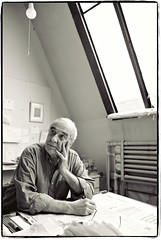
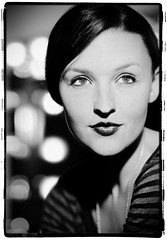
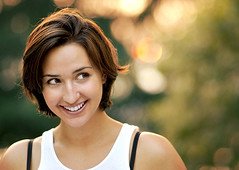
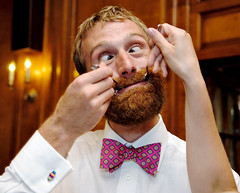

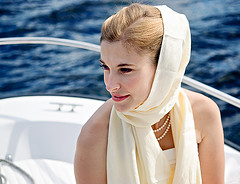


1) What got you into photography?
My parents laid the groundwork; my father was a camera collector and my mother would take seven rolls of film just because it was Tuesday, but it was really when I started getting quick results and losing the cost-per-shot that my interest was piqued. That happened first with film while working at a newspaper -- the photo editor would take it off and develop it and I'd see the results within the hour. Before that, it's kind of sad. I went to Greece for two weeks in '98 and took three photos.
Yes, I was photographing for newspapers before I was interested in photography. Life is weird.
2) When did portraiture become your strength, at least in my opinion it seems to be your strong suit.
I'm not so sure my strength is portraiture as much as pictures with people in them, since that's generally the only kind I care about. As I was trained at the newspaper, one of the first rules was "Photos are more interesting with people in them." I learned that before I learned what an f-stop was. We're trained by evolution to care about faces, eyes, gestures, for the countless permutations of them to each have meaning. We don't read as much in a sunset. There are maybe four great sunset photos, the rest are iterations of them.
3) How has flickr worked to help you along your way?
In too many ways to count; Flickr made everything snowball by having random people come by and say "Hey, that's pretty cool!" Instead of just messing around and having fun, it made me want to keep getting better and better. I deliberately keep everything I've ever posted up to Flickr, even though that's kind of a bad idea for the branding aspect of professional photography. I want people to see that my old stuff kind of sucked so they can see that the learning process continues. I know of photographers who did their best work maybe 40 years before they died, and that would be such an awful feeling.
4) Are there any photographers that you admire or seek to emulate?
More so all the time. I like the idea of bring the crazy, awesome war photographer drive and aesthetic to everyday shots, even commercial shots. How would Nachtway shoot a plate of food? How would McCurry shoot this wedding? Not in the pictures themselves, which might be scary, but bringing that relentless intensity even to jobs others would find boring. Just this week I discovered the work of Ben Chrisman, an insanely good wedding photographer who's *actually trained with Nachtway!* I want to be him when I grow up, and I need to hurry since he looks about six months older than me.
5) What's something in photography that you haven't figured out how to do yet?
Don't tell anyone at art school, but I've never shot large format. I have medium format rolls that have been waiting to be developed for two years; I'm kidding myself that I could get too into the LF processes. Maybe in a few years, when I get sick of doing things the way I'm doing them now.
6) What's some basic advice on taking a good portrait to someone just starting out?
Assuming you know how to take an exposure, it's all about the stuff that happens before you click the shutter. Is the person comfortable with you? Have you thought about the way they represent themselves, the way they are, the things that are appealing about them? A little bit of intention goes a long way. If subjects don't connect with you, that's going to show. Maybe they can smoke and look off in the distance dramatically.
7) What's your favorite lens/camera for taking portraits?
Depends on the type of portrait, but in general there's nothing like the 85mm f/1.4. I have to say the D3 to justify my expense, but except for the cropped frame the S5 was everything I could dream of for portraits. The D3 just gives me more DOF control and I can chimp again. Working with the S5 is basically like working with film. If you want to chimp you'd better take a coffee break for that buffer to clear.
8) What's harder to shoot, a bride or a model?
A good model is easiest, a bad model is the worst thing of all. A bride who's bad with the camera is still glowing and happy and in a nice dress and can easily become part of a great composition. A model trained only to look surly by reading magazines that care about clothing a thousand times more than people really gets under my skin, which is why I tend to work with actresses and chemists and web designers and entrepreneurs more than people who just dream of being on ANTM.
9) Tell us one piece of photography equipment out there that you'd like to get your hands on?
An AF-S Nikon 28mm f/1.4. I'm just waiting for it to exist.
10) Out of the 10 portraits chosen for Spotlight Seven, which is your favorite and why?

I'm always biased toward my more recent stuff, but that shot represents a new turn in my career. I've actually been doing some magazine and corporate jobs that bring me into contact with people who've led similarly fascinating lives, but I haven't been able to show much on Flickr. Plus, the shoot itself was a real success in one of the biggest skills needed for commercial work -- shooting under intense pressure. I managed to get the clean, emotional shots for an annual report by illegally setting up lights in Staten Island Ferry terminal, five feet from a security guard. In the 90 seconds he took to shut me down, I'd already set up the light and gotten the shot. (It wasn't my fault we didn't have permits, that's another story about pressure.) We were blocked from the shots we wanted on the ferry so I ran and found this tiny little stretch in the back, where again I managed to get just what they wanted. Then done with the safe ones, I was able to execute the shot I wanted in the 30 seconds or so I had left -- and it was capped off by that bird being in the perfect position.
All of that is nothing at all compared to the meaning of the man's life and the honor to represent it, but it means more to me because I wasn't just lucky, I fought like crazy to get things right. I like professional photography not because it makes me money, but because it presents me with an endless string of problems to solve. It keeps things interesting, and intensely rewarding.










Subscribe to:
Posts (Atom)
